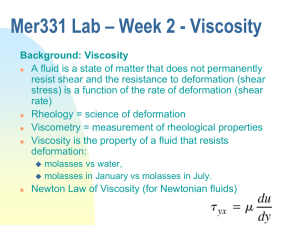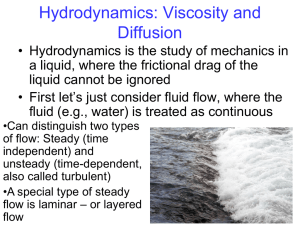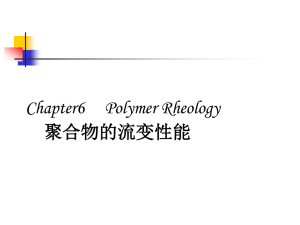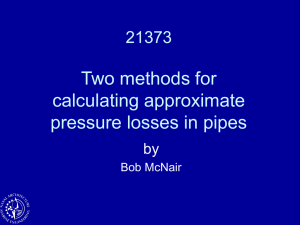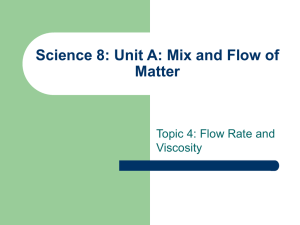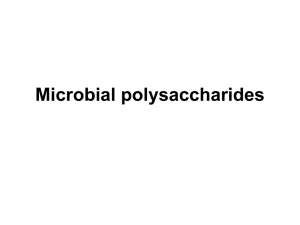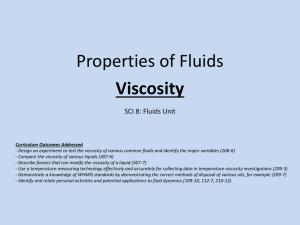Presentation on Viscosity
advertisement
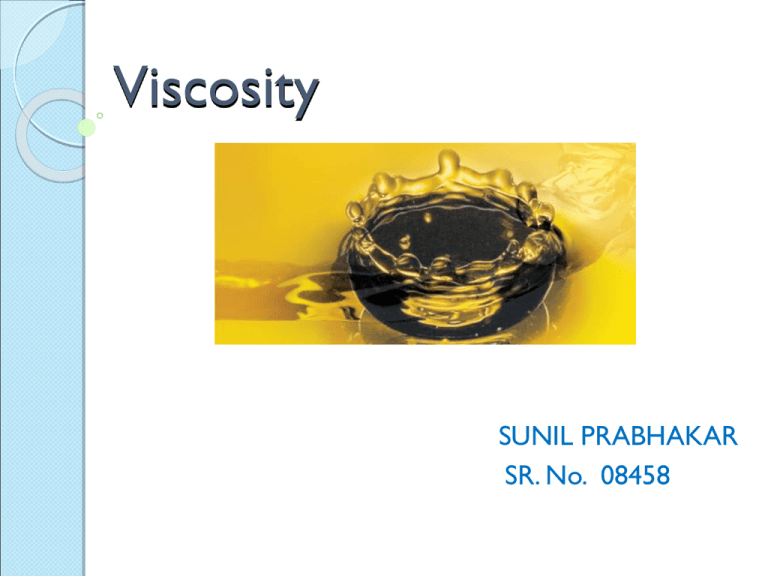
Viscosity SUNIL PRABHAKAR SR. No. 08458 Introduction Viscosity is a quantitative measure of a fluid’s resistance to flow. Dynamic (or Absolute) Viscosity: The dynamic viscosity(η) of a fluid is a measure of the resistance it offers to relative shearing motion. η= F/ [A×(u/h)] η= τ /(u/h) N-s/m² Kinematic Viscosity : It is defined as the ratio of absolute viscosity to the density of fluid. ν= η/ρ m²/s ; ρ= density of fluid Viscosity Measurements Capillary Viscometers It gives the ‘kinematic viscosity’ of the fluid. It is based on Poiseuille’s law for steady viscous flow in a pipe. Viscosity Measurements Rotational Viscometers These viscometer give the value of the ‘dynamic viscosity’. It is based on the principle that the fluid whose viscosity is being measured is sheared between two surfaces. In these viscometers one of the surfaces is stationary and the other is rotated by an external drive and the fluid fills the space in between. The measurements are conducted by applying either a constant torque and measuring the changes in the speed of rotation or applying a constant speed and measuring the changes in the torque. There are two main types of these viscometers: rotating cylinder and cone-on-plate viscometers Viscosity Measurements Rotating cylinder viscometer Viscosity Measurements Cone-on-plate viscometer Effects of temperature The viscosity of liquids decreases with increase the temperature. The viscosity of gases increases with the increase the temperature. Effects of temperature The lubricant oil viscosity at a specific temperature can be either calculated from the viscosity - temperature equation or obtained from the viscosity-temperature ASTM chart. Viscosity-Temperature Equations Effects of temperature fig: Viscosity-temperature characteristics of selected oils Viscosity index An entirely empirical parameter which would accurately describe the viscosity- temperature characteristics of the oils. The viscosity index is calculated by the following formula: VI = (L - U)/ (L - H) * 10 where , VI is viscosity index U is the kinematic viscosity of oil of interest L and H are the kinematic viscosity of the reference oils Fig . Shows the evaluation of viscosity index Effects of pressure Lubricants viscosity increases with pressure. For most lubricants this effect is considerably largest than the other effects when the pressure is significantly above atmospheric. The Barus equation : Effects of pressure Viscosity - shear relationship For Newtonian fluids, shear stress linearly vary with the shear rate as shown in Figure.Viscosity is constant for this kind of fluid. τ = η (u/h) Non Newtonian fluid doesn’t follow the linear relation between viscosity and shear rate. Viscosity – shear relationship Pseudoplastic Behaviour Pseudoplastic or shear thinning and is associated with the thinning of the fluid as the shear rate increases. Thixotropic Behaviour Thixotropic or shear duration thinning, is associated with a loss of consistency of the fluid as the duration of shear increases. The opposite of this behavior is known as inverse thixotropic. Applications Selection of lubricants for various purpose. - we can choose an optimum range of viscosity for engine oil. - for high load and also for speed operation high viscous lubricants is required. In pumping operation - for high viscous fluid high power will require. - for low viscous fluid low power will require. In making of blend fuel - less viscous fuels easy to mix. In the operation of coating and printing. References ‘Engineering Tribology’ by “Gwidon W. stachowiak” and “Andrew W. Batchelor”. ‘Engineering Tribology’ by “J.A.Williams”. www.wikipedia.org www.google.com

